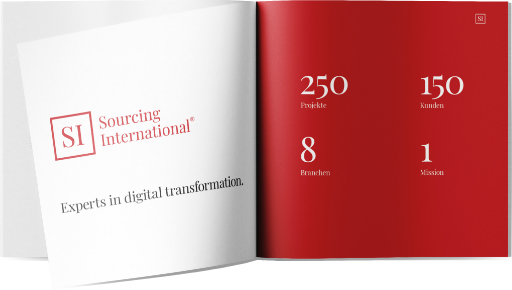Global app for beauty pros: Streamlining consent and salon management
This story shows how we prototyped and developed an MVP with the goal of making beauty artists' lives easier by managing all their appointments, clients and consent forms - no matter where they are located. It was an ambitious project where we collaborated with 40+ partners, clients and subcontractors to get the app ready to launch.
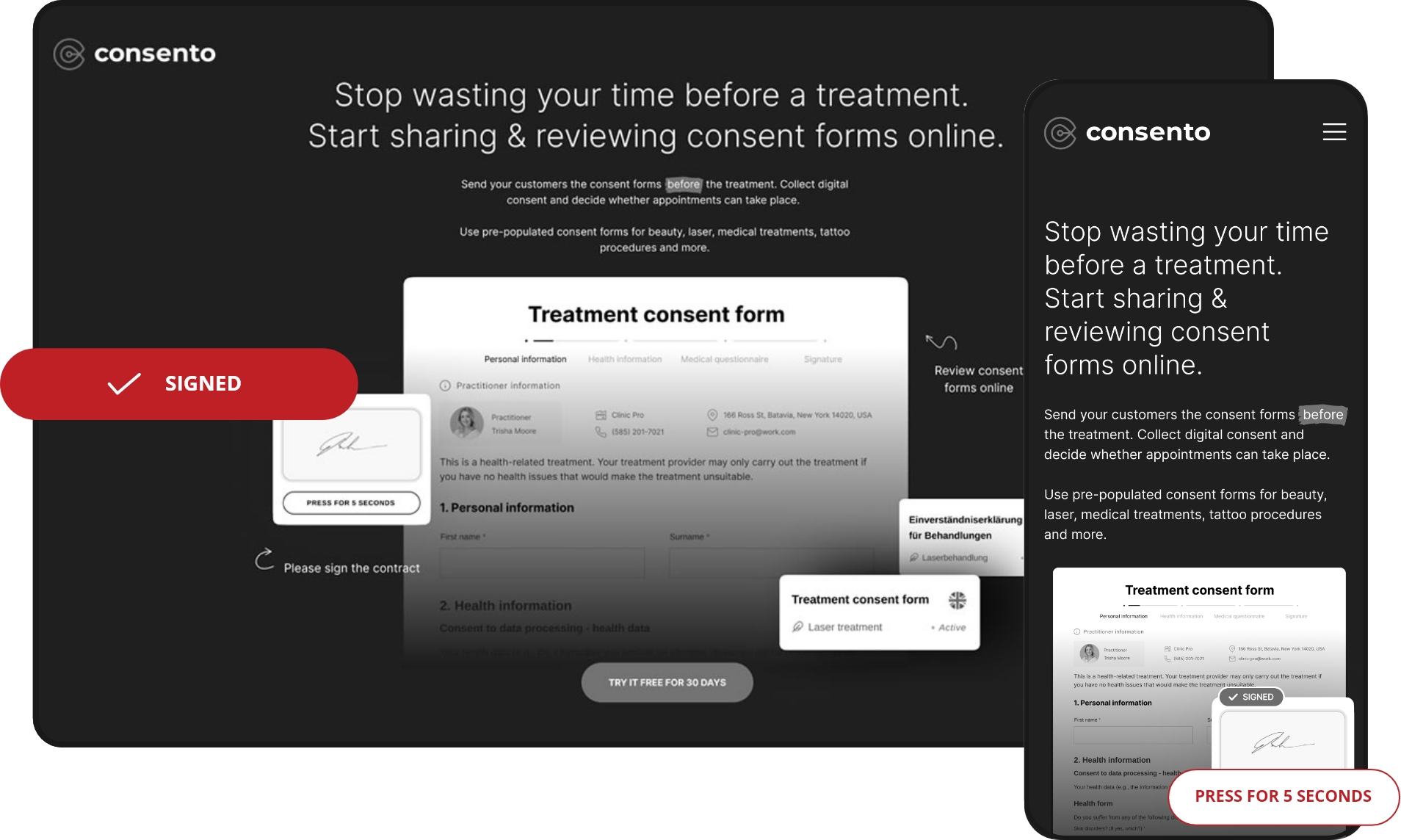
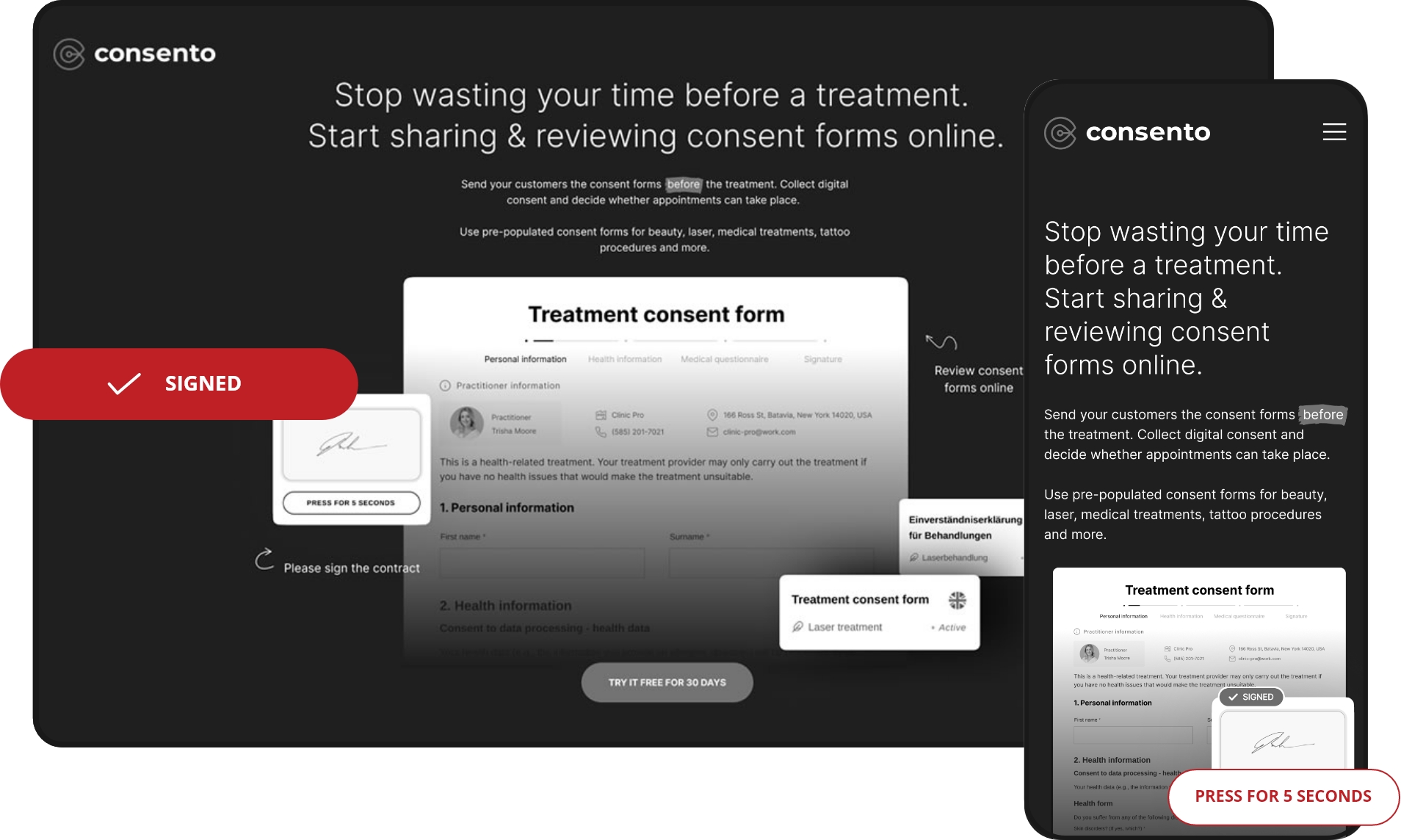
Outcome
In less than a year, we have developed an app that can replace multiple tools, enabling beauty professionals to focus on providing a great experience for their customers.
Our consento app is now ready for the market and offers a wide range of useful features for beauty professionals. This all-in-one app allows salon owners to efficiently manage employees, appointments, treatments, techniques, clients and consent forms. consento now focuses on the beauty industry, but can be adapted to meet the requirements of other business sectors where consent is needed upfront by the customer.
The context
We identified challenges faced by clients in the beauty industry that could be addressed with a salon management app. To better understand the market, we created a customer journey map outlining the process from booking appointments to providing feedback. This helped us identify key moments for enhancing the experience and streamlining processes for beauty professionals.The journey map inspired many features, but we needed to prioritize a select few for developing a Minimum Viable Product (MVP) while planning future enhancements. A crucial component of the app is managing consent forms, especially in heavily regulated areas where signed forms are mandatory before treatment. This process includes assessing the client’s medical history and medication to prevent complications.Sometimes, when a client arrives at the salon, they receive a form to fill out. However, they may realize that there are certain conditions that make it impossible for the treatment to be performed. This wastes time for both the professional and the client.
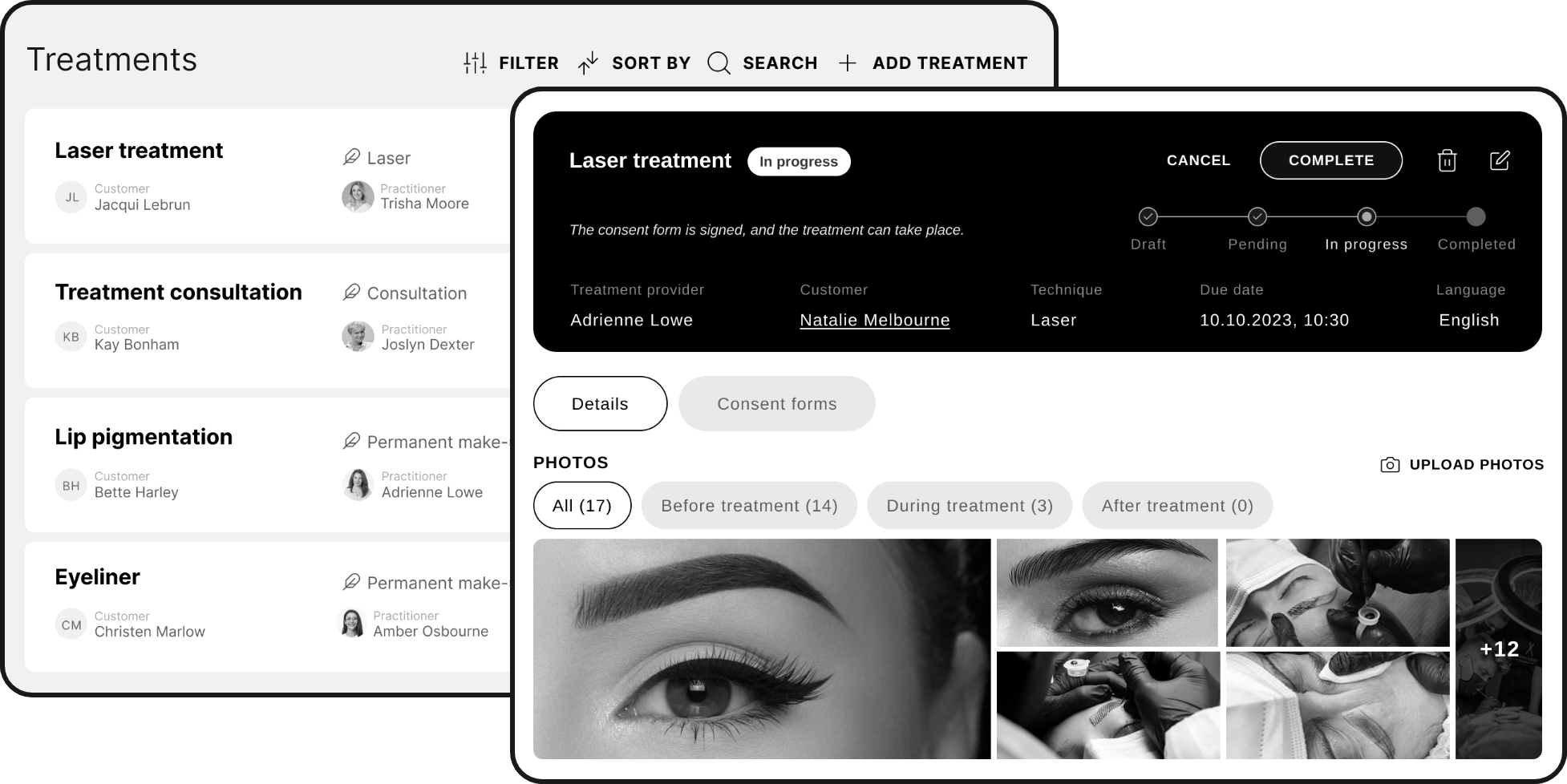
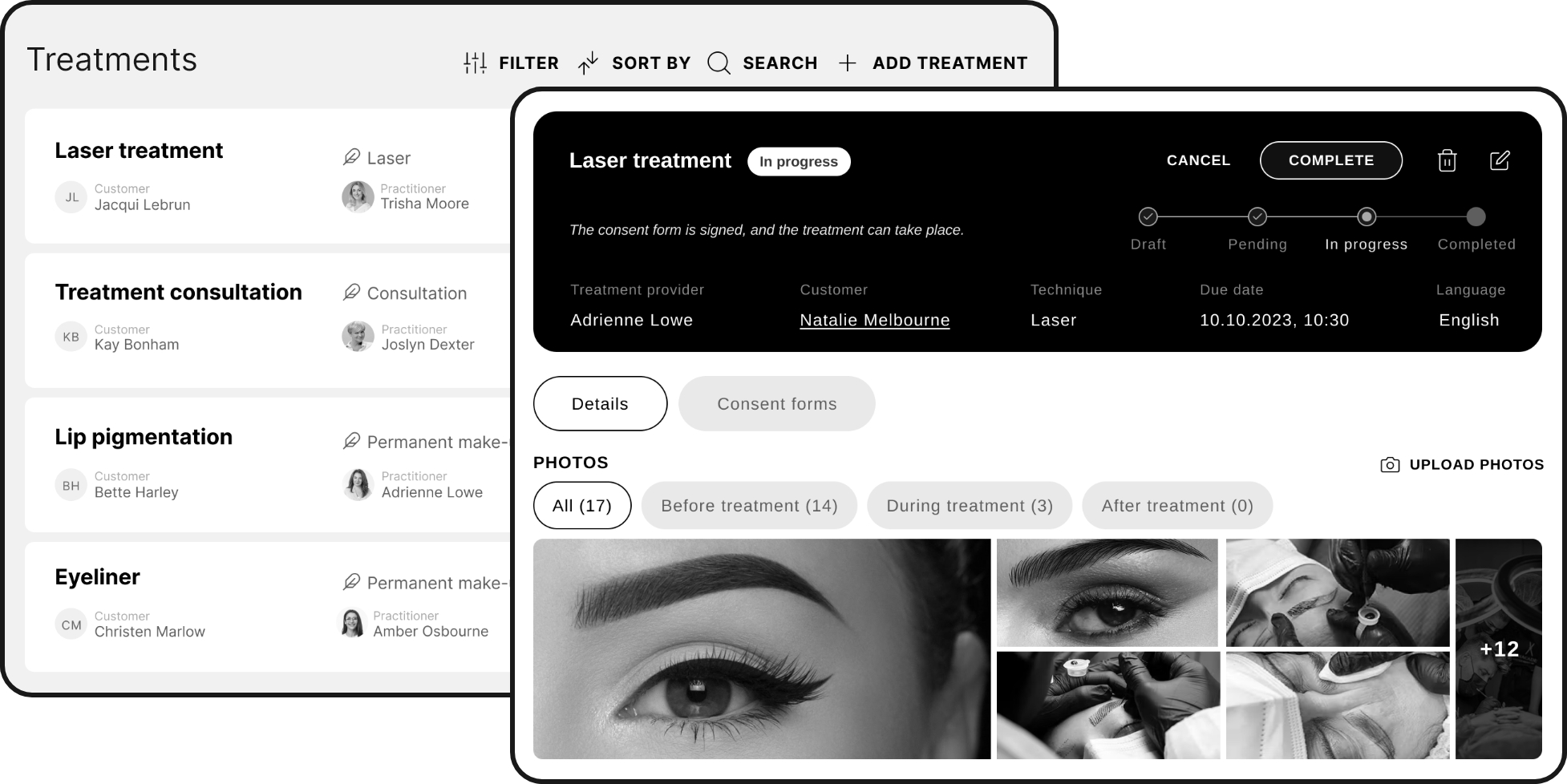
MVP concept: Bringing the most value to clients
The features that are essential for our MVP focus on salon and treatment management, as well as the process of sending, signing and reviewing consent forms.Workspace managementThis is where beauty professionals can manage all their activities within the salon. Owners (admins) can invite other artists (team members) to their workspace in order for them being able to use consento for the treatments they perform - their daily work. Within the workspace, artists can manage all upcoming treatments, create new ones, manage the customer database and the techniques available for treatments, as well as creating new, or editing existing consent forms that will be sent to the customer upfront for signing.Treatment sessionsWhenever a booking is made, beauty professionals create a treatment session within consento. They can then assign the appropriate consent form to the session and send it to the customer for review and signing. Beauty professionals can see the status of each session to know if the consent form has been signed. They can also access all relevant information related to the treatment and decide whether the treatment can proceed. Additionally, they can track the products used and upload photos with customer consent. All details are stored in the app for easy access.Consent form signingAfter a new treatment is created in consento and the consent form is sent, customers receive an email notification informing them about the upcoming procedure. They review, fill in, and sign the form digitally. Once signed, the artist is notified in the app to proceed with the treatment.
Competitive research
We conducted competitive research to evaluate user satisfaction with similar products, focusing on challenges like creating consent forms, setting up appointments, and managing salon operations. We examined products like Appointmend, Calendly, DocuSign, Fresha, PandaDoc, SimplyBook, Treatwell, and others. This research provided valuable insights into the market and customer preferences, guiding our product development.
01
Identifying market gaps
02
Setting benchmarks
03
Inspiring innovation
04
Understanding trends and customer expectations
05
Improving messaging and communication
Our process
Once the product strategy, features list, and timeline were finalized, we initiated a tender process to select the best contractor based on strategic fit and multiple factors. We employed agile methodologies like Scrum to organize development activities and meet our goals.As new team members joined, including a Scrum Master and an additional UX designer, we faced challenges in maintaining alignment among the larger team with our vision.
Development
consento was designed to provide a seamless, engaging, and user-centric experience, built with modern web technologies and scalable architecture. The backend was developed using Laravel and the frontend utilised Vue.js 3, delivering a dynamic and responsive interface. These technologies worked together through a well-structured API, ensuring smooth communication between the backend and frontend, and laying the groundwork for possible mobile app integration.It was developed with a multi-tenant architecture. This approach allowed the platform to efficiently serve multiple users or organisations, each with isolated data and configurations. The use of tenancy ensured scalability, security, and data integrity, making it adaptable to a wide range of client requirements.It featured a fully responsive design, ensuring it adapted seamlessly to different screen sizes and devices. Moreover, it prioritised smooth page transitions and quick navigation, delivering a polished and uninterrupted user experience.
Downscaling
At one point in the timeline, we realized that having a smaller and more agile team would help us get closer to launching our product faster, as the core of the application was already built. As a result, we decided to keep one designer instead of four. Also, we selected two external developers and one tester. As a result, the core team now consisted of the head of product, a product manager, three full-stack developers, a tester and a UX/UI designer. This new approach allowed us to maintain quick decision-making and alignment."The best product team is one you can feed with two pizzas." - Jeff Bezos
Bias for action
Fast decisions lead to faster product development and innovation. These are the principles we applied:
Act quickly on available information: We made decisions based on the best available data at the moment, rather then waiting for perfect clarity. Quick decisions often lead to faster learning and iteration.
Fail fast, learn faster: For our team, it was more important to make progress and adjust along the way than to wait until every detail is perfect. Mistakes can be corrected, but stagnation leads to missed opportunities.
Iterate frequently: Rapid, small iterations allow for frequent testing of assumptions and faster course corrections, reducing the impact of any single wrong decision.
UX principles
To create the best product, we applied User Experience principles and tested the app's functionality early on. We assessed usability through heuristics like system status visibility and error prevention, identifying improvement areas before real customer testing.We standardized layout elements for consistency and refined UX writing for nudges and messages. Extensive testing was conducted across various locations and devices, particularly addressing challenges in adapting the app for mobile, ensuring a seamless user experience.
Testing with users
We had an exciting moment when we onboarded some salons and artists to test consento and provide feedback.Findings:
Clients don't like to read long forms, so we needed to find a way to go through the consent form chapters more efficiently.
Customers sometimes miss to fill out fields, so we needed to highlight the respective sections.
Artists want to get client consent to use the photos from the treatments, so it's important to get that right.
Artists need to see upcoming treatments quickly, so we decided to pre-filter treatments for an easier overview.
They wanted an overview of how the business was performing, so we thought that a dashboard with statistics would be helpful to them
Beauty professionals need to be able to edit some of the data provided with the customer at the salon.
A "share" button to send the consent form for signing via WhatsApp would be ideal, as everyone uses it.
This was a great opportunity to improve the MVP before going to market. We analysed the feedback and planned the small improvements we could make now, with a great impact on artist and customer satisfaction.A few more sprints followed before we were ready to launch.
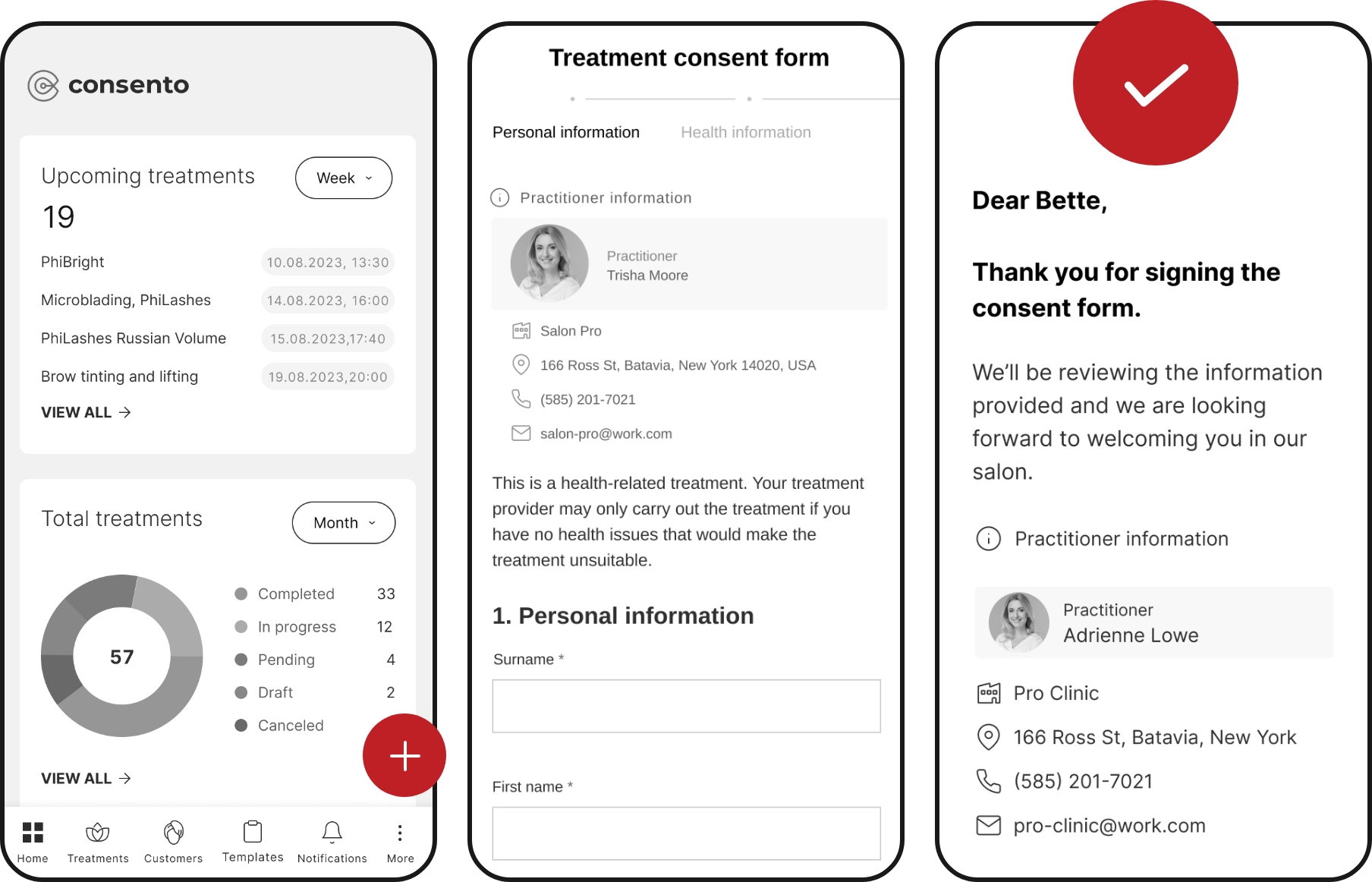
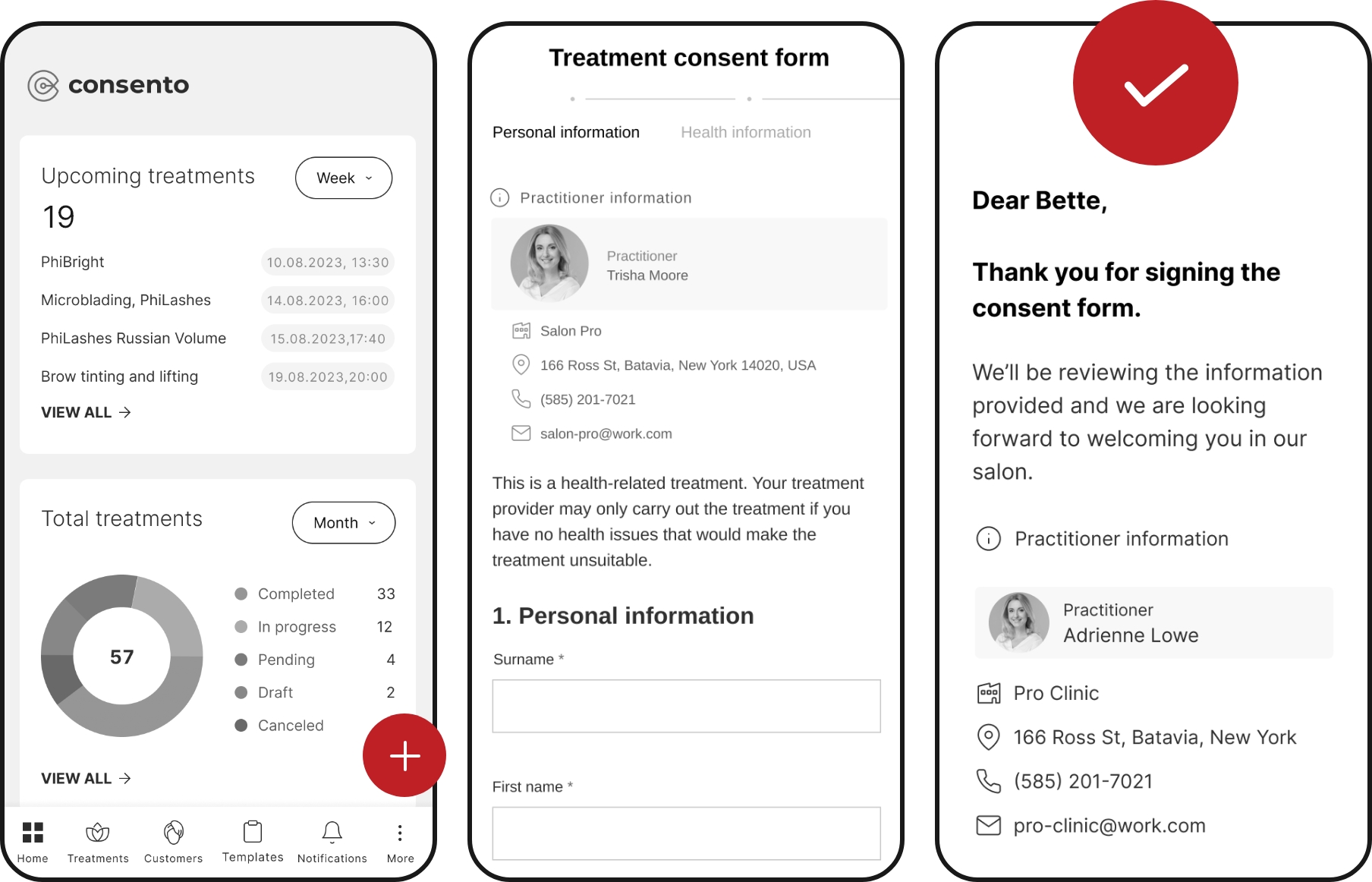
The benefits
consento brings many benefits to artists and customers from all over the world.Save time with less paper & easier signatures86 + hours artist get back every year. 15 minutes less for every treatment. consento enables customers to review & sign consent forms prior to their treatment, from any device, meaning that artists can focus on what matters to them.Achieve legal compliance & assuranceArtists can safely collect and store treatment consent forms provided by their customers. You never know when these may come in handy in the future.Document the treatment pathBuild a journal of events for each of the treatments, and associate documents or relevant mentions to customers.Expand the portfolioArtists can gather consent for using treatment photos in their business and marketing activities.Track suppliesTake notes of the products and colors used in a treatment.Oversee salon activitiesAchieve an overview of the treatments done by a team of artists.
Lessons learned
During this process, we learned that it's better to work with a smaller and more agile internal team instead of hiring a large external team. A smaller team tends to be more motivated and driven. Overall, cutting back on resources can lead to faster progress.Another important lesson we learned is the importance of getting to market quickly. It's beneficial to test assumptions as early as possible, even if we don't have all the features we want to offer. Having a few core features that work well and provide value is enough to gather valuable feedback from clients, which can shape our roadmap.
Feedback
The clients’ feedback after the testing session was positive. They appreciated the app’s streamlined design, which consolidates all information in one place and provides visibility into upcoming treatments. They valued the ability to upload photos and materials, along with the efficient filters that enhance navigation.Clients found the process of selecting treatments, creating customer profiles, and automatically generating consent forms to be particularly convenient. Overall, the app is simple and intuitive to use, resulting in a positive experience.
The team

Product Manager, Alumnus

Product Manager

Full-stack Developer, Alumnus

Product Designer
More success stories
Get in touch
Quality consultation
How we help clients
1
Strategy, Governance & Compliance
We help clients develop tech strategies and compliance frameworks.
2
Digital Transformation
We design key digital transformation projects on behalf of our clients.
3
Application
We successfully implement the most demanding technology projects.
4
Organisational Identification
We support our customers in developing a vibrant organisational culture.
